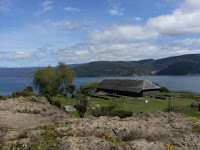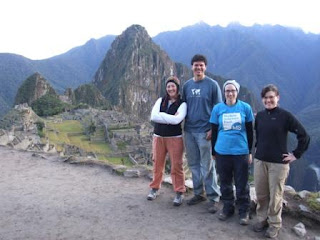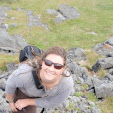Ok, now that that is clear, and you obviously agree with me, I can start from the beginning.
I took a very comfortable bus ride down to Valdivia from Santiago in late October, from about the 16th to the 26th. I would certainly recommend this company to anybody. The prices seemed very reasonable to me. I think it certainly helped that I had a stunning view the whole way down, sitting in the front row on the second floor of this bus. At first is was much like a roller coaster ride, because of how far from the ground I felt and the fact that I could not actually see the front of the bus. But I watched for nearly 12 hrs.(the length of the bus ride) as the landscape and ecology changed around me. And always in view were the Andes.
Here is a link: http://www.turbus.cl/commerce/inicio.jsp
You can easily get to the bus station by taking the metro to University of Santiago, passing through the metro terminal to the bus station. Super fácil.
Arriving pretty late, my professor from the Austral University, Mauricio Soto-Gamboa came to pick me up from the bus station. We spent Sunday at their beautiful home just outside Valdivia. Carmen, a grad student and long-time polola of Mauricio's was so wonderful the whole time, making amazing meals for us to share. They were so kind. I could not remember when I had felt so at home in a place.
On Monday, the real work started. We discussed the data and I began the analysis, working for 3 straight days, solid. On Thursday, I finally came out of the zone with enough analyzed data to discover.... nothing really. We ran the data through Statistica and found that the preliminary results were not going to give us much insight. I would need to continue to analyze other elements and characteristics of the data, include the ecological data and run the analysis again. My professor also reminded me, that no results are also results.
Mind you, I did have several breaks from staring at a computer screen. When the weather turned from rainy and dull to bright and sunny, we went into town to have a lunch of fresh fish and salad. I was also invited to several guest lectures, which was very interesting.
Thursday night, we went to several carretes, all included delicious grilled foods, which all the grad students, of course, gathered around. People were so friendly and accommodating that I couldn't believe I was still in Chile! These parties went long into the night, and I was really glad when on Friday I was given the option to work from the house.
On the weekend, I did the tourist thing, wandering about the city. Entertaining myself at the fish market, and watching the gathered wildlife waiting for handouts:


One-stop shopping at the faria


Tiuque ataque!!!
Chimango Caracara also known as Tiuque (Milvago chimango) is a species of bird of prey in the Falconidae family. (from Wikipedia)
Gulls, comorants, vultures, and sea lions, oh my!
Comorant hanging out near the action.
Big lobos marinos resting on a dock.
Look at that face!
From the all the action of the market, I decided to take a bus to Niebla, a town nearby that sported fort preserved from colonial times. On the way, I was so taken by the views, I got off the bus as we entered town to take photos.
As I wandered further into town, I practically stumbled into the fort. It was a lovely place, the views were stunning, and the museum inside the what I can only imagine were the barracks was very informative.
My adventures continued as I returned to the city of Valdivia. I spent a few hours getting lost in the city's botanical gardens, and afterword found myself investigating into the whereabouts of of a place where everyone in the main plaza had stopped to get delicious looking ice cream. I used my investigative skills and followed the trail of very happy people to a chocolateria! It was the most enjoyable ice cream I had had since Imporio La Rosa in Santiago. I took in the sites and sounds of the city as the day came to a close.
Church=site.
The last and final day of my visit, Dr. Soto-Gamboa took me along to go recover some data loggers from a field site located in the stunning Valdivian forests. It was exhilarating to be wandering through such a lovely place on such a perfect day, as the weather was cooperating. After collecting all the data loggers, and pausing on several occasions to listen to and observe some of the wildlife, we returned to the field truck. Mauricio said that we had some time, and so I bolted down the the nearby cay to explore the beach. Always a child at heart. But can you blame me:

I left that night to return to Santiago, eternally grateful, to my Chilean adviser. I learned so much in that short week, and saw some pretty amazing things. I can't imagine doing anything else in my life than being where I am and doing what I am doing right now!!
However, I will admit that I am homesick. I miss everyone back home, but I know that time will pass quickly and Christmas will be here before you know it!








































